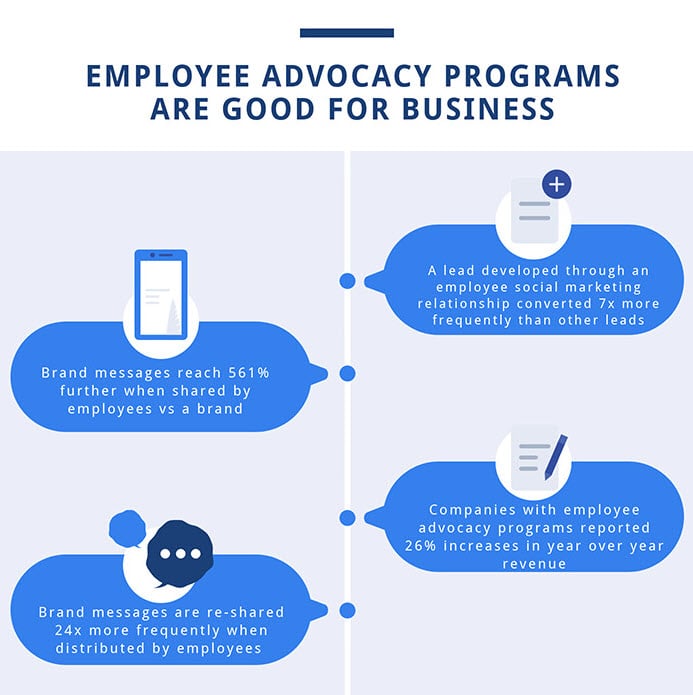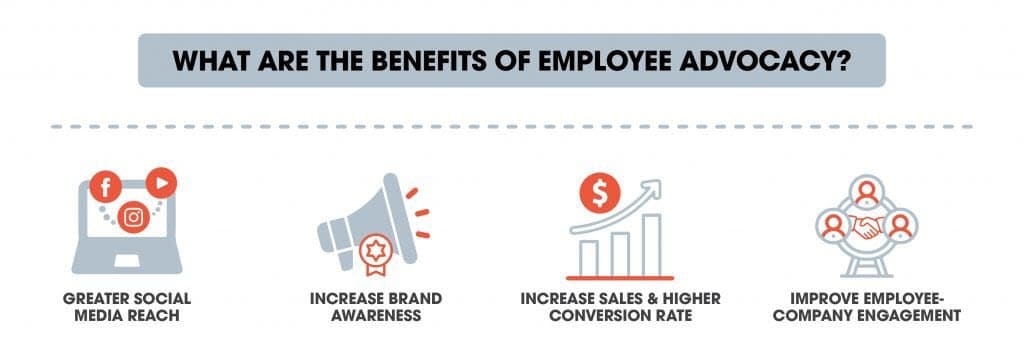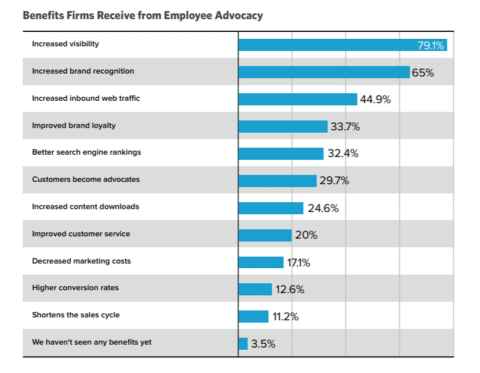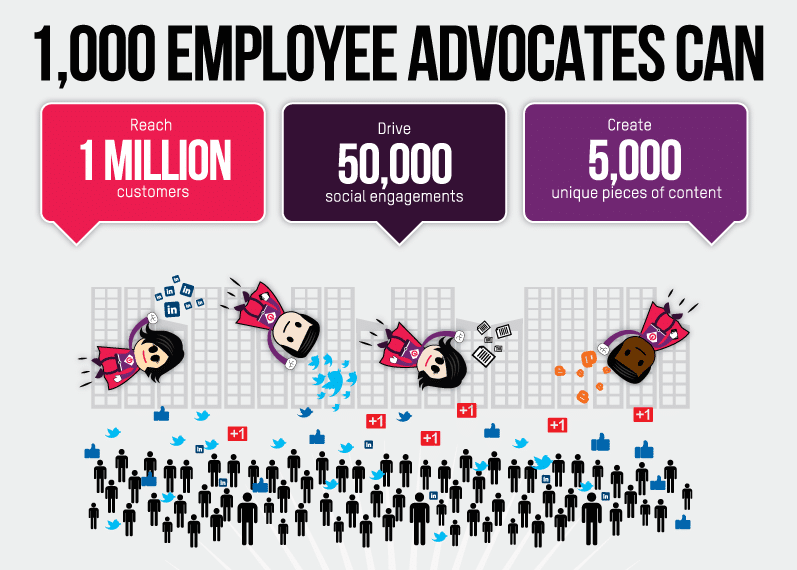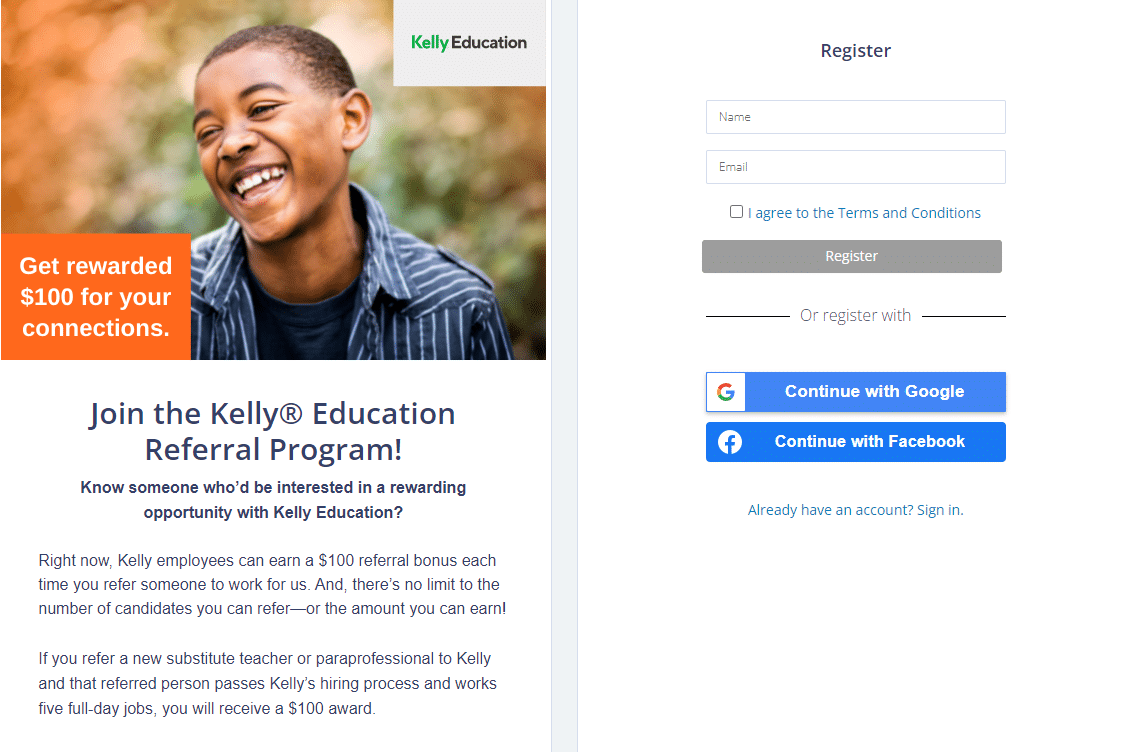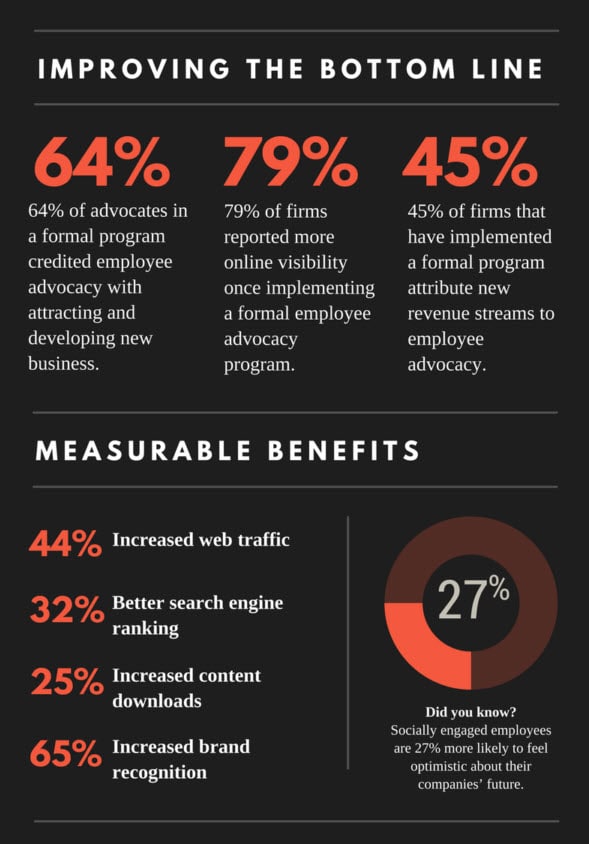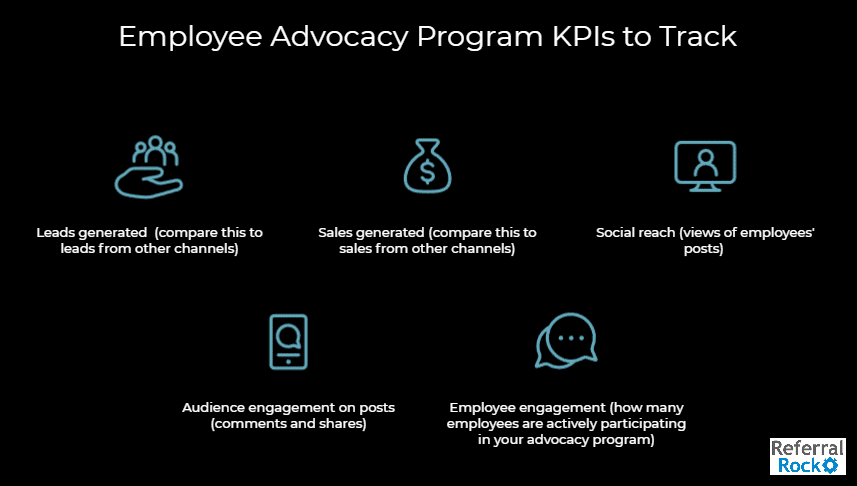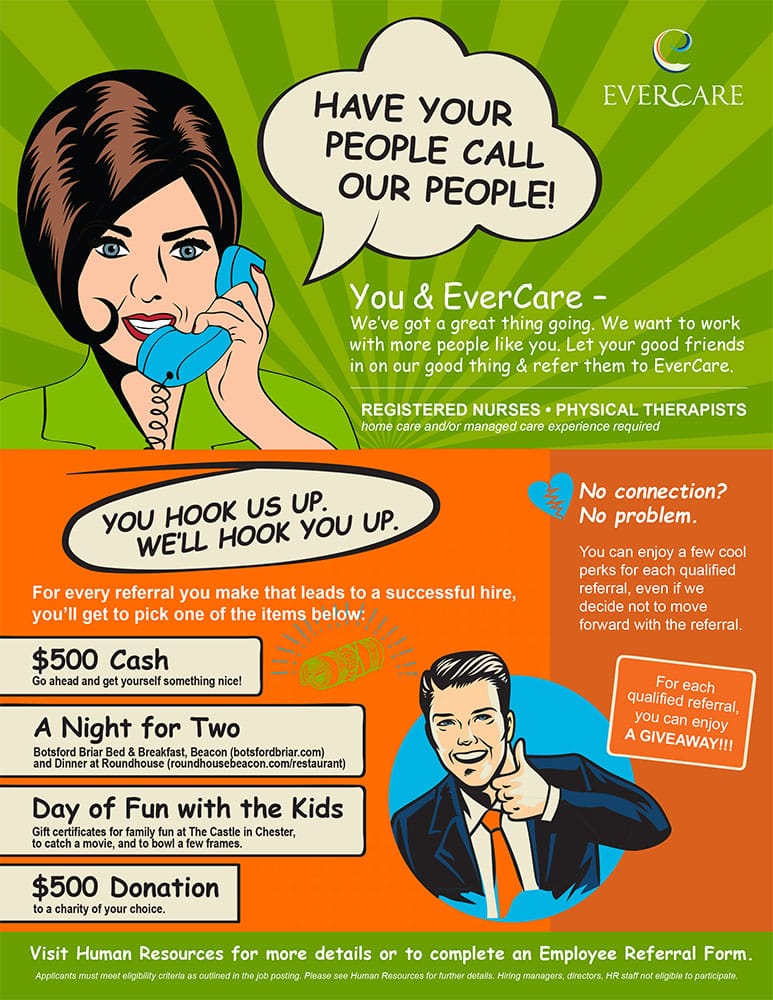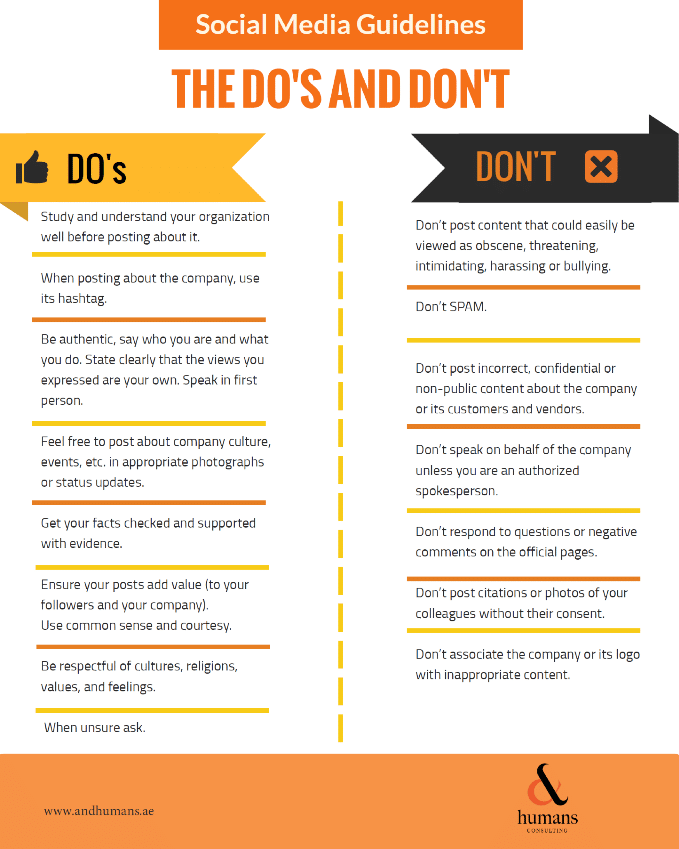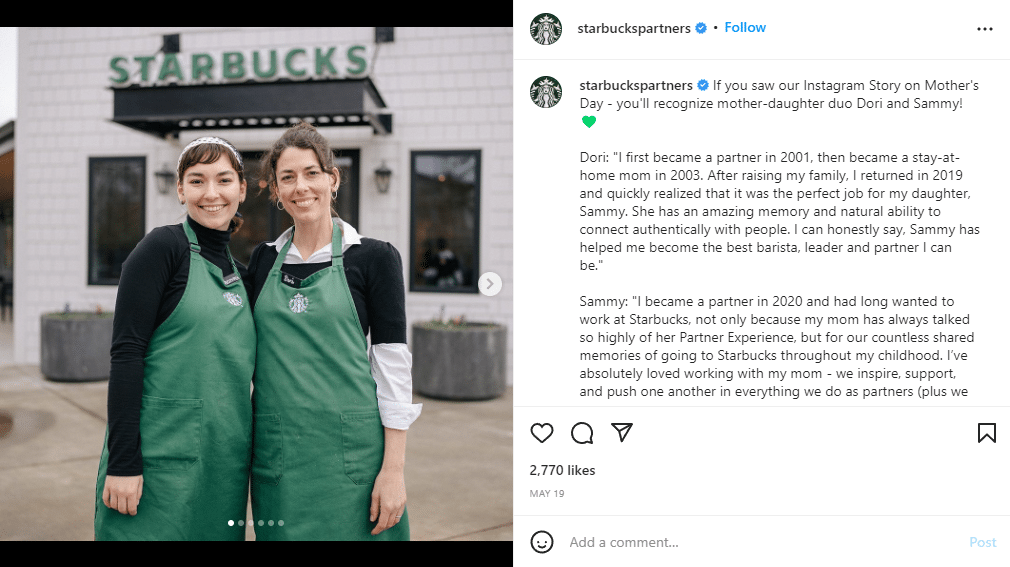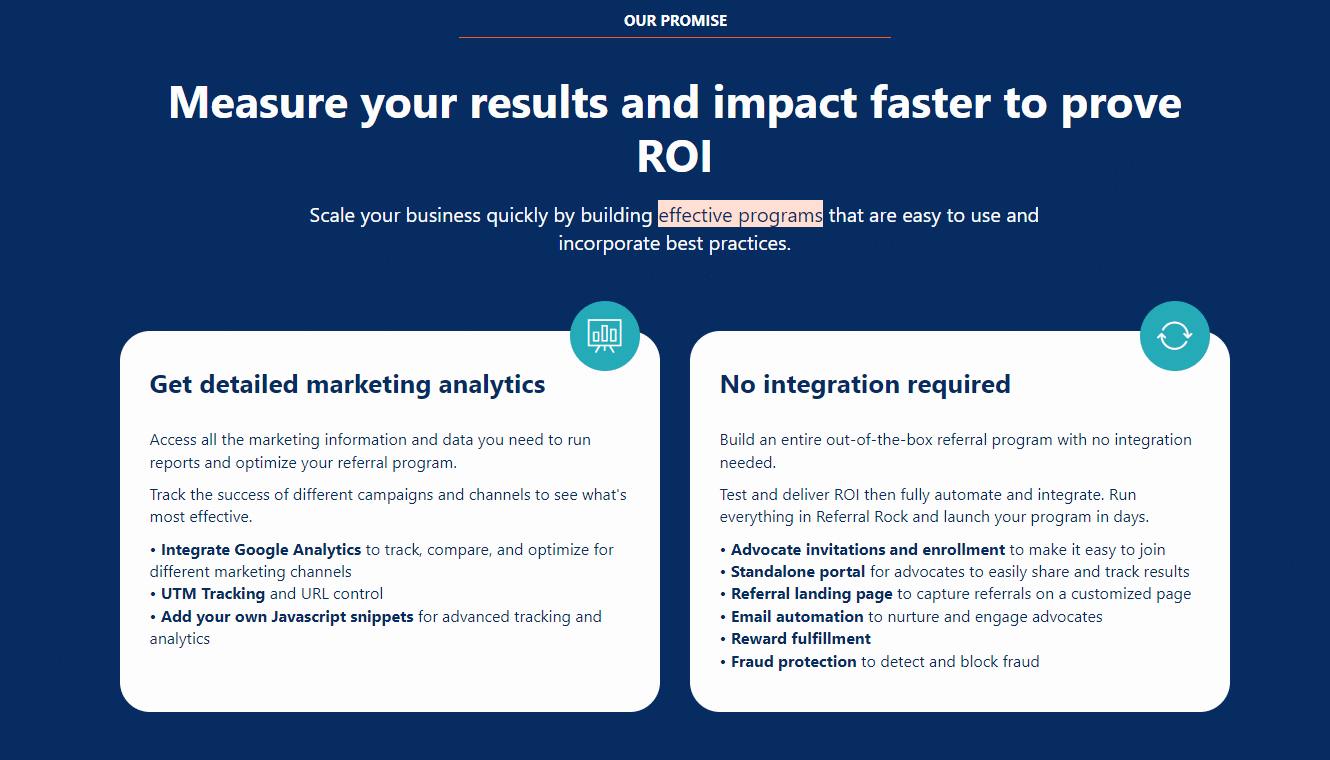You couldn’t ask for a better endorsement than having a customer refer you to others. But what happens when your company’s employees make referrals too?
Brand advertising just doesn’t have the same credibility and appeal anymore. The average consumer likes to do their research ahead of time and figure out whether a brand is really worth it before giving up their time, effort, or money. And that’s where the power of employee advocacy comes in.
Learn what employee advocacy is, why you need it, the different types, and how to set up your own employee brand advocacy program in this guide:
What is employee advocacy?
Employee advocacy can be defined as when a company’s employees become loyal promoters (advocates) of that company’s brand and products. Any employee, not just a marketer or salesperson, can be an employee advocate.
In most cases, employee advocacy happens online via social media platforms, but it can also take place when employees refer the company to individual friends and family members.
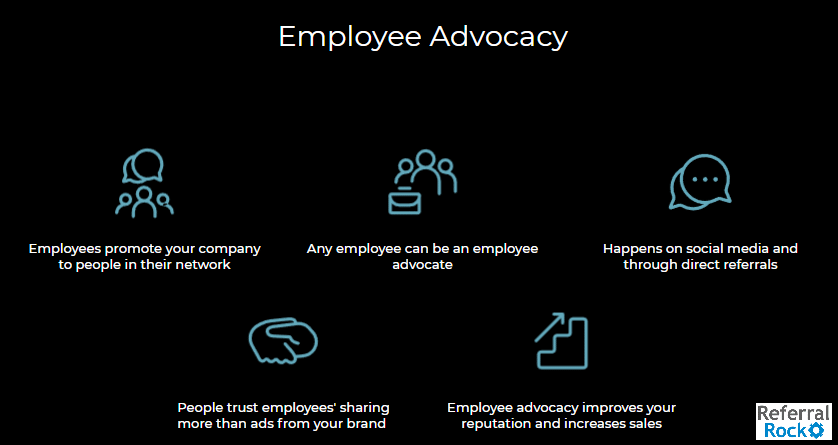
During employee advocacy efforts, employees promote your company to others in their network, typically friends, family, and peers. Employee advocacy involves some form of sharing of your products, news, content or even company culture in a way that makes your brand appealing, engaging, and worth checking out.
Why employee advocacy is important
Employee advocacy is more important than ever for businesses, no matter your size, scale, or scope. If you’re not engaging in some form of employee advocacy to supplement your marketing efforts, you could be missing out.
A well-known study by Nielsen identified that 92% of consumers around the world trust earned media, such as word-of-mouth or recommendations from friends and family, above all other forms of advertising when making a purchase decision. This means that friends and family members are more likely to trust employee sharing over any form of direct advertising by your brand.
Also, when employees choose to promote you, it reflects positively on your brand. That’s because, when an employee shares your brand, it shows that they value it – they’ve put in their own time to tell others about it. The sharing can also appear a lot more organic in nature when compared to traditional brand advertising. It’s a lot like social selling minus the mistrust and caution. After all, it’s not the company bombarding a potential customer with brand messages, but someone they know, like, and trust starting a conversation.
Last but not least, there is trust and credibility in numbers. The more word-of-mouth your brand generates through your employee network, the better your brand reputation will be among your target audience’s wider community.
Benefits of employee advocacy
The list of potential benefits that an employee advocacy program can bring to your business is long, as long as you implement your program properly. Here are the most notable benefits:
Expanded reach and engagement
A formal employee brand advocacy program can help you significantly increase your reach. A recent study by Hinge Marketing shows that employee advocacy increased brand visibility for 79.1% of brands, brand recognition for 65%, and inbound web traffic for 44.9% via social networks. Employees tend to have 10 times the network reach of brands.
Cumulatively, employee advocacy can increase your brand reach by as much as 561% and help you achieve eight times more engagement on your company content—all the more reason to create a brand advocacy program as part of your digital marketing strategy.
Authentic sharing and lead generation
Your employees have the potential to become your best brand advocates. The reason is simple – they know your brand inside and out. When your employees share company news, content, and updates, they do so from a genuine place of authority. Thus they will be able to reflect your brand’s values and messaging more authentically, and you will receive more qualified leads (and more sales).
A streamlined employee advocacy program also makes it much easier for all employees to share your brand online.
Niche expertise
Widespread knowledge-sharing among team members enables the development of expertise. Through the process of learning and sharing, your employees get to expand their knowledge base. This, in turn, turns them into credible ambassadors for your brand and the specific niche you’re targeting.
Improved employee engagement
Having rewards (tangible or intangible) for promoting the company can create highly engaged employees. Employees feel more motivated when they know their concerted efforts to share content affect the bottom line. They also gain the opportunity to develop their personal brand, which can be a powerful intrinsic incentive for many. This recognition and incentivization on repeat can make your employees feel highly engaged, resulting in increased company performance over time.
Types of employee advocacy
Employee advocacy can come in many forms. While the basic idea behind an employee advocacy program is more or less consistent across the board, companies may modify the specifics based on what fits their brand the best. We’ll be covering some of the most common types of employee advocacy programs next.
Employee referral programs (employee-to-customer)
Employee referral programs come in two types – employee-to-customer referral programs, and employee-to-employee referral programs.
In an employee-to-customer referral program, employees directly share your brand, products or services with people who may be interested in them. There’s no restriction on the number or type of employee who can participate. Employees are also welcome to participate for as long as they like, and as often as they want.
The sharing employee earns a reward (called an employee referral bonus) every time a referred friend makes a purchase. And if you use employee referral software, every referral is tied back to the employee who made it via a unique referral link. Using referral software simplifies the process of staying on top of referrals and ensuring payouts are done automatically to the employees after a sale.
Employee referral programs (employee-to-employee)
In employee-to-employee referral programs, your employees are not promoting your products or services, or encouraging sales. Instead, your employees refer potential candidates for job openings at your company, functioning somewhat similarly to talent scouts.
Like the employee-to-customer program, your employees earn rewards for referrals. In this case, a referral is when a potential candidate progresses through the recruitment stages – whether that’s submitting an application, participating in interviews, or eventually getting hired.
When employees actually receive the rewards can be dependent on the company. Some companies will payout only at the time of hire, and some will provide an additional reward after the candidate successfully completes 3 or 6 months in the new role.
Similar to employee-to-customer referral programs, the sharing process is streamlined and tracked thanks to referral software, and all employees can participate in the program as often as they like.
Employee ambassador programs
Your employees can be your best brand ambassadors. Employee brand ambassadors can appear more genuine and likable compared to brand advertising. Keep in mind, though, that authenticity doesn’t always come through naturally when there are brand guidelines and a media policy to stick to. So, it’s essential to train your employees on how to be authentic while promoting your brand, both online and offline, as official representatives.
As with all other advocacy programs, employee efforts are tracked and rewarded. Usually, companies don’t open the program to every employee, though. While all employees are welcome to participate, they must first undergo formal training and induction before becoming official employee ambassadors.
Social media employee advocacy strategy
As the name suggests, a social media employee advocacy program encourages employees to post about your brand on their personal social media channels.
Employees can share any type of company content in the way that feels most natural to them, with some ‘control’ measures. For instance, they do have to adhere to the brand’s voice and tone, and ensure the content is in line with the brand’s messaging guidelines. Because of this, it’s crucial to provide training for employees. But at the same time, your strategy should be flexible enough to allow the employee to share their authentic voice.
The good news is that the training for a program like this can be done entirely online. Aside from brand guidelines and do’s and don’ts in the form of a social media policy, you can also cover how various social media platforms work and how to create social media posts, for example.
Like other advocacy solutions, employees receive rewards for sharing.
Organic employee advocacy
In organic employee advocacy, your employees share your brand and messaging without being asked or incentivized to do so. It’s always desirable to have your employees naturally share your brand. It speaks to how much they appreciate your brand and stand by your products and services. Given this, organic sharing can be the most trusted and authentic form of advocacy marketing for new leads and sales.
But this type of organic referral can be hard to track since it happens outside of a formal employee referral program. It can also be less reliable in terms of results as there is no motivation in the form of incentives to share.
Natural sharing takes place as a result of a strong company culture. When you’re committed to a winning relationship with your employees in everything you do, whether it’s communication, management, employee-driven payroll, or acknowledgement of employee efforts, it can translate seamlessly into organic sharing.
What is an employee advocacy program?
An employee advocacy program is a formal program that a business creates to manage and track employee advocacy. Increasingly, companies prefer to use software for this purpose because of the ability to create and track referral links and measure performance on top of day-to-day management.
Formal employee advocacy programs usually include social media marketing, given that employees can easily share links to their wider network of potential leads and customers. But that doesn’t mean the referring is carried out entirely online. As part of an employee advocacy program, employees may also be empowered to directly refer customers offline as well.
Employee referral programs, ambassador programs, and social media strategies are all included under the common “employee advocacy program” umbrella.
How do I set up an employee advocacy program?
Although the different types of employee advocacy programs have their own best practices, the ones we’ve outlined below work across the board for all employee advocacy programs.
The steps below will help you avoid any potential pitfalls, and sail through employee advocacy program design like an expert. Use these pointers to build a highly effective employee advocacy program from the ground up.
Set goals for your program
Without setting goals for your program, it can be hard to determine how far you’ve come or how well your program is doing. Before developing a program, you want to spend some time deciding the goals you want to achieve.
Bear in mind that goals can be individualistic. Different brands have different ideas of what would constitute an ideal goal to reach, but here are some of the most common ones:
- Increase brand awareness: Brand awareness is simply about how familiar the audience is with your brand, and it’s also about how recognizable your brand is or how much ‘brand recall’ it has. Positive brand awareness helps you build trust among consumers and enhance brand equity.
- Improve social reach: Social reach is how many people see your content on social media platforms like Facebook, Twitter, LinkedIn, and Instagram. It can also refer to how much ‘exposure’ your content receives.
- Improve social engagement: On a basic level, engagement refers to the shares and comments you receive when you post your content online – a measure of how appealing your content is to your target audience.
- Generate leads: Lead generation is about identifying prospects who have the potential to convert to customers. From an online perspective, it’s about creating content that attracts potential leads, ideally in the form of email subscribers or followers, who can be nurtured during the sales cycle.
- Drive direct sales: This is perhaps the easiest of all goals to measure because of its immediate and visible impact on the bottom line.
- Improve customer retention: Some employee advocacy programs, like employee referral programs, encourage both customer retention and acquisition. So, it may be worth measuring retention of referred customers vs. other customers.
- Improve employee engagement: Human resources teams often talk about employee engagement. The phrase simply describes how dedicated, enthusiastic, and committed employees are towards your brand and working for you. Happy employees are more productive in their work output and achievement of outcomes. They can show the most significant potential to become ‘natural’ brand ambassadors.
- Any other goals? Other goals can relate to what you as a brand feel is relevant for your program, not covered on this list.
Once you’ve decided the goals you want to achieve through the employee advocacy program, you’ll need to determine how you will measure your program’s success. Similar to the process of goal-setting, measuring success in the form of metrics or KPIs (Key Performance Indicators) varies depending on the brand’s unique objectives and approach.
Lead generation and sales output are the easiest to measure, in terms of conversion efforts and impact on the bottom line. They’re also easy to track as part of a formal employee advocacy program.
But it’s also a good idea to supplement these with social media marketing. It’s hard to measure the impact of reach and engagement on your bottom line unless they’re linked via a marketing funnel or pipeline. Still, they can be core drivers for brand ‘likability’, which can ultimately increase sales. And you can still track reach and engagement in the form of visible metrics such as impressions, comments, shares, and likes.
It’s also a worthwhile investment to track employee engagement. For instance, you can look at how many employees are actively participating in your advocacy program (define what ‘actively’ means to you). You can use surveys or focus groups to get a sense of the employee sentiment, if you feel like efforts are not at the level they need to be. These will help you identify snags that need to be addressed.
Find the leaders of your advocacy
In an ideal world, all employees have the potential to become marketing mavens, but this isn’t always the case. Authentic marketing doesn’t necessarily come naturally to everyone. It’s a good idea to start small with a focused group of your brightest before you roll out the fully developed program to all your employees. These handpicked advocates are the ambassadors for your ambassador program, so to speak!
Look for the following when you’re selecting employees for your focus group:
- A solid social media presence with a credible network and demonstrated thought leadership. Are they leading the conversation, driving change, or inspiring others?
- Consistent organic sharing of your brand. This proves a natural enthusiasm and interest in promoting your brand, making any sharing look authentic and genuine.
Invite your selected employees personally to your focus group to garner additional enthusiasm and provide a sense of exclusivity. Work with your employees for a set period on a mini-scale, implementing your proposed social media initiatives.
Solicit ongoing feedback on what’s working well and what’s not. You can also ask for input on what types of rewards employees would find the most exciting and motivating. You’ll want the feedback to prep the program for a successful formal launch. Act on feedback where relevant, because your ultimate aim is to keep scaling your program to more and more employees.
Decide how you’ll reward employees for participating
Providing rewards or incentives is necessary to building a successful employee advocacy program. Ideally, you should give rewards based on lead generation and sales, as these are the easiest to measure. Plus, you can correlate the value of the rewards to the value of the lead or sale.
Having regular conversations with your focus group should give you some indication of the types of rewards that would work the best. If the reward isn’t exciting enough, you simply won’t achieve the best results.
Traditionally, cash payouts work the best because employees know the value of the reward, and they can spend it however they want. But other types of rewards can be popular too, such as:
- Tickets to conferences, sports games, or concerts
- Gift cards
- Travel allowances
- Spa or gym memberships
- Company swag such as backpacks or higher-end water bottles
- Tech items like mobile phones or tablets
Provide training in social media sharing
Your employees could be the best at what they do at work, but that doesn’t mean that they’re necessarily experts at all things social media. If you’ve chosen thought leaders, perhaps their content just needs that final bit of polish and fine-tuning to bring them up to scratch.
Provide basic social media training, including how to take and post the best photos for representing your brand. Give guidelines on what type of images work the best, plus basic editing tips and how-tos. The training should also include the essentials of required brand hashtags, and how to share unique referral or ambassador links for tracking purposes. Also, share best practices depending on the selected social media platforms.
Cover all the branding and messaging guidelines for promoting your brand. Present this as a comprehensive list of social media do’s and don’ts, which can serve as a quick guide for easy reference.
Your guidelines should:
- Cover your values and mission, and how to showcase those on social
- Outline how messaging should be conveyed to reflect your brand’s tone and style
- Provide practical examples of what to say and what not to say when representing your brand
- Talk about controversial topics you don’t want your brand to be associated with
- Discuss rules of confidentiality – what can’t be shared
Don’t overwhelm your employees with information, though. You also don’t want to sound regimented – keep it fun and exciting. Otherwise, you simply won’t get buy-in.
- Package your guidelines in an appealing and attractive format.
- Keep the content short, concise, and easy to read. Nobody likes to read large walls of text with nothing to break up the monotony.
- Think about integrating videos and example images to make things interesting.
While sharing guidelines, you still want to emphasize the need for the employees’ true voice to come through. One of the most crucial aspects of positive brand sharing is authenticity. You’ll want to encourage your employees to share about your brand as naturally as possible within the structure of your brand guidelines.
You could provide ready-made templates for guidance, but as far as possible, avoid sharing the exact message to be sent out. The templates should function more like prompts, giving your employees ideas to work with. For example, you could ask your employees to share why they love your product, or talk about a company initiative that helped them. Follow up with examples of how to share in a conversational way, without sounding salesy.
Provide training in making referrals
Aside from providing training on social media skills, you’ll also want to train your employees on how to actually manage the process of referrals.
Start with training on how to share referral links to customers, or how to submit direct referrals of potential customers or employees to the business. Show your employees everything they need to know about using your chosen advocacy software solution. Also, review how they can track the status of their referrals, the incentive structure, and how and when the payments or incentives will be transferred to them.
Promote your employee advocacy program
Next, you’ll want to start promoting your employee advocacy program, so your employees know that such an initiative exists. A warm and personalized invite is a great way to encourage employees to participate in the program, whether in conversations, emails, or Slack messages. Follow up with posting about the program on company-wide Slack channels and other employee-only spaces.
You could also mention the program during meetings, or create dedicated in-person or virtual presentations. Discuss what the program is all about, how it works, and what’s in it for employees who sign up and actively participate.
Keep employees in the loop
A crucial element of a formal employee advocacy program is ongoing communication. You always want to stay in touch with your brand advocates and keep the channels of communication open.
The ideal solution is to create an advocacy portal, which is usually included in advocacy software (an employee advocacy platform). Alternatively, you can use a Slack group to provide a dedicated space for program updates, assets, promotional materials, and training materials. The idea is to bring together all parties involved in the program together for information sharing, general updates, and notifications of competitions and challenges.
Ensure your employees know who they can contact for any questions or concerns they have. Also, be sure to add a feedback form, or solicit feedback at relevant intervals, to monitor how the program is doing. Act on that feedback to make your program better than ever.
Make employee advocacy part of your company culture
Lastly, remember that employee advocacy is not a concept that should be completely isolated within a program. Rather, employee advocacy has to permeate your entire work culture from the top down. That starts with ensuring your employees feel valued, because when your employees are motivated, they’ll want to share your brand naturally.
Start with reviewing if there’s anything that’s preventing your workplace culture from being as stellar as it can be. Form an action plan as to how you’ll overcome these roadblocks. To complement your cultural restructure, look at practical things you can do to make your employees feel appreciated and part of the team.
For instance, you could recognize top advocates (over a month, quarter or year) in company meetings and online employee spaces – or maybe even publicly – and give them extra rewards for their impressive performances.
Top 5 employee advocacy program examples
Now that we’ve reviewed how to create a successful employee advocacy program, let’s look at some examples of employee advocacy programs. Below, we’ll cover five real-life companies that have put the above tips into practice.
Starbucks
Starbucks has dedicated social media accounts for just employees called ‘Starbucks Partners’. The content features employees at work as they go about their day, and sometimes includes exciting tidbits provided by the employees themselves.
The Starbucks Social Media Guidelines is a great example of how to issue simple but comprehensive guidelines for employees. It features a list of dos and don’ts together with contact information. It also encourages participation with a call to action to share employee stories.
Adobe
Adobe had very specific goals for their employee advocacy program:
- They wanted employees to understand the type of content they could share externally.
- They wanted tools that would help employees use their social networks more powerfully.
- They wanted to create a means for effective communication internally for information sharing and driving employee engagement, as well as a community experience.
They knew that, done right, employee advocacy would amplify social engagement, traffic, leads, and ultimately sales.
All of Adobe’s employees were encouraged to share their genuine experiences at Adobe through organic social content, in an effort to show the brand’s human side. But the brand especially focused on showcasing their C-suite’s expertise, because it knew that its audience gravitated towards thought leadership. They also organized the info needed for content creation carefully, in a large series of groups.
Result-wise, the efforts have led to an organic reach of over 3,000,000 on social media, while each employee in the program has an average social network of over 4000 people.
GE (General Electric)
General Electric’s social sharing is a fantastic example of how to use an employee advocacy program to recruit quality candidates. The program was started chiefly to address the lack of candidates applying for their open positions, owing to negative brand perception. The goal was to change public perception and streamline recruitment by making the brand an attractive company to apply for.
The campaign started with training HR teams on how to humanize their employer brand and online profiles. An ongoing feedback loop was included in the training to ensure that the training would meet the expectations of the target audience. The result of employee sharing within the first month of program implementation was a whopping increase of 800% in the number of applicants – showing the potential of effectively leveraging employee sharing.
In 2019, General Electric even let its employees take over all of the GE social media accounts, to show what the company was working on from the employees’ perspective.
MasterCard
MasterCard is a case example of how a supportive workplace culture can drive successful employee advocacy.
The company incorporates best practices for Diversity, Equity, and Inclusion across the board. They also offer a number of additional employee benefits, including:
- Benefits for the self and family (new parent leave, family building support, counseling sessions, financial support for education, bereavement leave)
- Financial assistance through dependent scholarships, family assistance funds, and tuition assistance
- Employee recognition programs
- Flexible work schedules, including remote work options
MasterCard’s employee advocates share brand content enthusiastically across their social media networks, with hashtags such as #mastercardambassador, during work hours. The program was developed in consultation with employees during the initial stages of development, and included specific initiatives that train employees on social media best practices.
Salesforce
Salesforce wanted an employee advocacy solution that would live inside of Salesforce, so that sales teams could “easily discover, customize, and share content to their professional social networks in just a click.” Over half of the sales reps spent more than 3 hours daily on their homegrown solution, so they wanted an employee advocacy tool that allowed for seamless integration.
Using software they were able to, among other things:
- Provide content scheduling tools for the employees, easing the process of planning content ahead of time.
- Provide feedback mechanisms for employees to offer topic suggestions.
- Curate content that matches the employees’ topics-of-interest
- Gain in-depth analytics into the performance of individual posts.
- Create transparency in the form of a leaderboard that was available to all employees (which also added an element of gamification)
Employee advocacy tracking and software
If you’re a small business or just starting out, you may be tempted to go down the manual route for tracking, measurement of results, and payouts to employees. It’s common for businesses to resort to documents and spreadsheets. But manual methods are prone to errors and can be easily misinterpreted. It’s also easy to lose or miss out on critical information.
And what happens when you decide to grow your business? You will start to find it challenging and overwhelming to manage all the moving parts as your business starts to scale. That’s where employee advocacy software comes in.
Software tracks employees’ efforts
While social sharing is a critical aspect of an effective employee advocacy program, measuring its results can be challenging. It’s better to track the leads and sales that employee advocacy brings in. Provide unique referral or ambassador links for your employees to share online. Since these links can be tracked, you can determine exactly when they’ve brought in a sale.
How to choose the right employee advocacy software?
There are many different options for employee advocacy software in the market. Determining the ideal choice for you can be overwhelming, but it doesn’t have to be complicated. Use the following checklist to help you pick the right software for your needs.
Know the different types
There are three main types of employee advocacy software – employee referral software, employee brand ambassador software, and other employee advocacy software. The three types of software can be fairly similar with a few basic differences and some overlap.
- Employee referral software is used to manage the process where employees refer your brand to others, whether that’s potential customers or potential job seekers.
- Employee brand ambassador software manages the process where employees function as your brand ambassadors to promote your brand.
- There are also other types of employee advocacy software, which focus on creating employee advocacy programs beyond the referral and ambassador models.
Evaluate key features
Automation is a given with current software in the market, but it’s still worth a mention here. The software should be able to automate the end-to-end process of managing referrals, including notifying all the relevant parties about a sale and ensuring the employee receives the payout. If it automates the creation of an employee advocacy portal, that’s even better. You can use the portal to house all your trainings, employee engagement processes, and internal communication related to the referral program.
Tracking and analytics are also key. The employee advocacy software should be capable of creating tracking links for each of your referring employees. It should be able to provide notifications on sales and provide detailed analytics on employee advocates’ performance.
Also, check on additional features. Look for software that integrates with your existing marketing and sales stacks, so you can easily connect to the tools you already use. In addition, look for flexibility, so you can customize the software to your unique needs.
Referral Rock employee advocacy software
Looking for comprehensive, easy-to-use, and flexible employee advocacy software?
Referral Rock software is flexible enough to manage any type of employee advocacy program (including employee referral and ambassador programs). But you don’t necessarily have to run all the programs. Simply pick and choose what fits your specific needs.
Your program will always be on-brand, thanks to comprehensive customization features. Plus, our software automates many of the routine tasks associated with running an employee advocacy program, including creating tracking links and issuing rewards. We even automate program promotion, to keep your program top-of-mind with your employees.
And thanks to our tracking and measurement features, you can easily measure your ROI in real-time with speed and accuracy. Identify what’s working and what’s not so you can make the right decisions to reduce risk and boost your profitability.
Referral Rock integrates with over 30 of the most commonly used marketing and sales tools, including HubSpot, Google Analytics, WordPress, ActiveCampaign, and MailChimp. In addition, our dedicated onboarding specialists will help with everything you need to launch and customize a program.
Conclusion
Whatever the size or scale of your operation, an employee advocacy program is a vertical worth looking into, not just for marketing but also for increasing employee engagement. Happy employees can be your most effective brand ambassadors. Use these guidelines, in tandem with an employee advocacy software solution, to build a successful employee advocacy program that works from the ground up.

